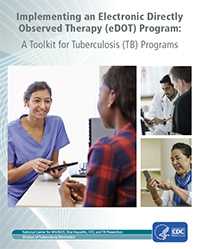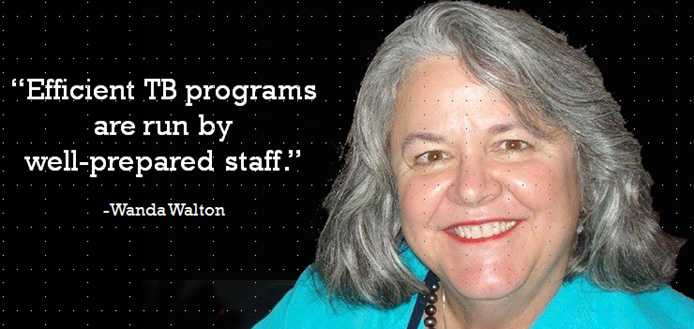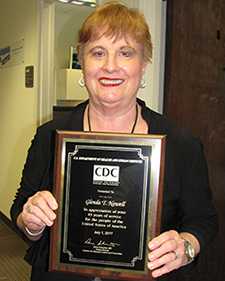TB NOTES

TB Notes 32017
Notes from the Director
Dear Colleague:
This past spring, Division of Tuberculosis Elimination (DTBE) staff have been involved in a variety of events. DTBE hosted a TB Expert Network Conference in late April with the CDC-funded TB Regional Training and Medical Consultation Centers (RTMCCs) and the National Jewish Medical Research Center. This conference served as a forum for TB experts to discuss challenging or complicated cases. The conference focused on clinical conundrums in the HIV-TB co-infected patient.
The Tuberculosis Trials Consortium (TBTC) held their 39th Semi-Annual Meeting in May in Atlanta. The meeting highlighted research on the diagnosis, clinical management, and treatment of latent TB infection (LTBI) and TB disease, as well as an exciting collaboration with the Tuberculosis Epidemiologic Studies Consortium (TBESC) to study a 6-week LTBI treatment regimen. The 8th annual Tuberculosis Epidemiologic Studies Consortium (TBESC) meeting was held May 18-19 in Atlanta. The meeting highlighted current and planned TBESC studies that encompass elements of LTBI testing, treatment, program evaluation, and opportunities to increase uptake of testing and treatment, such as working with community providers. In addition, DTBE staff traveled to California to meet with the California Tuberculosis Elimination Advisory Committee to assist in the development of a clear, focused TB prevention communication strategy.
Congratulations to the Surveillance for Tuberculosis Elimination Management System (STEMS) Development Team, winners of the June 2017 National Center for HIV/AIDS, Viral Hepatitis, STD, and TB Prevention (NCHHSTP) Director’s Recognition Award! DTBE developed STEMS to streamline LTBI patient management. The real-time data can be used to graphically demonstrate a local program’s progress in identifying persons in their jurisdiction who need to be screened for LTBI, evaluating them completely, beginning treatment for those with LTBI, and documenting completion of treatment. STEMS was officially released on January 13, 2017.
As we enter the last half of the year, I continue to be inspired by your dedication to the very important work you are doing every day in our efforts to eliminate TB. I hope all of you have a safe, enjoyable, and productive summer.
Philip LoBue, MD, FACP, FCCP
Director,
Division of Tuberculosis Elimination
National Center for HIV/AIDS, Viral Hepatitis, STD, and TB Prevention
Communications, Education, and Behavioral Studies Branch Updates
Communications, Education, and Behavioral Studies Branch Updates
Social Media
DTBE’s Twitter account, @CDC_TB, recently surpassed the 3,000 follower mark. Since 2015, DTBE has used Twitter to share research, promote new tools and resources, and raise awareness of TB. DTBE’s Facebook account, @CDCTB, launched in September 2016, has also been steadily growing, with over 700 followers. Social media continues to be an important communication tool to reach new audiences and stakeholders in TB elimination.
Submitted by Leeanna Allen, MPH, DTBE
Latent Tuberculosis Infection Online Resource Hub

The Latent TB Infection Online Resource Hub is a collection of downloadable materials for informing and educating the public, health care providers, policy makers, and other partners about the importance of expanded latent TB infection testing and treatment. It is a one-stop-shop for information, guidance, fact sheets, and messages on targeted testing recommendations for latent TB infection. There is also a gallery of social media graphics, web buttons, infographics, and slide sets for use in education and outreach to clinicians and communities.
Submitted by John Parmer, PhD, DTBE

Implementing an Electronic Directly Observed Therapy (eDOT) Program: A Toolkit for Tuberculosis (TB) Programs.
DTBE is pleased to announce the release of Implementing an Electronic Directly Observed Therapy (eDOT) Program: A Toolkit for Tuberculosis (TB) Programs.
The purpose of the toolkit is to assist TB programs in developing and implementing an eDOT program. The toolkit provides a general overview of eDOT, steps for implementing a TB eDOT program, and sample forms that can be tailored to fit individual TB program needs.
If you have any questions or would like more information, please contact Peri Hopkins at phopkins@cdc.gov and Sarah Segerlind at ssegerlind@cdc.gov.
Submitted by Peri Hopkins, MPH, DTBE
Retirement of Wanda Walton, PhD, MEd— Branch Chief for the Communications, Education, and Behavioral Studies Branch (CEBSB) in the Division of Tuberculosis Elimination (DTBE)

Wanda Walton, PhD, MEd— Branch Chief of CEBSB in DTBE, will be retiring on July 31, 2017. In 1989, Dr. Walton joined the U.S. Centers for Disease Control and Prevention’s (CDC) Division of Tuberculosis Control as the first TB/HIV Health Education Specialist. Charged with the task of developing training materials for healthcare providers, she soon recognized the need to develop accurate and up-to-date materials for patients, their families, and communities, as well. Upon stepping into the role of Chief of the Communications, Education, and Behavioral Studies Branch (CEBSB) within CDC’s Division of Tuberculosis Elimination (DTBE) in 1999, she assembled a team of Health Education Specialists, Health Communications Specialists, and Behavioral Scientists. This team has worked to develop a comprehensive TB-specific website that allows providers and patients to easily access TB information 24 hours a day in both English and Spanish. They also conduct behavioral studies to inform improved program practice; develop culturally and linguistically appropriate patient education materials; create and sustain the TB Education and Training Network; and develop continuing education training materials, online training courses, and communication materials for a wide variety of health care providers.
In addition to her work focusing on the elimination of TB in the United States, Dr. Walton has provided training and technical consultation to assist countries around the world to strengthen their TB care and prevention capacities. Some examples include: China, where she worked alongside TB program staff to adapt the Self-Study Modules on Tuberculosis to their program; the Philippines, Thailand, India, and Ethiopia where she facilitated “Training of Trainers” courses; Vietnam, Nepal, Philippines, and Bangladesh where she reviewed staff training needs and programs; and Peru, Estonia, and Latvia, where she contributed to MDR-TB training and education.
It is simply not possible to quantify Dr. Walton’s contributions to ending TB. Her visionary approach and decisions are often mirrored by other nations. For more than 25 years, her talent, enthusiasm, and commitment to creating and sharing knowledge and resources, and to building capacity from within has been preparing and inspiring countless educators around the world to do the same. As a result, her efforts have strengthened TB prevention and control from frontlines to boardrooms, all over the world. Dr. Walton’s service and dedication to improve global TB literacy have been greatly appreciated. In retirement, she plans to travel, perfect her pound cake and cornbread recipes, and spend more time with family and friends after moving to Birmingham, AL.
Submitted by Sloane Bowman, MPH, DTBE

Laboratory Branch Updates
Tuberculosis Laboratory Aggregate Report
DTBE Laboratory Capacity Team (LCT) recently released the Fourth Edition of the Tuberculosis Laboratory Aggregate Report [PDF – 4 MB]. Data detailed in the report are self-reported by public health laboratories supported, in part, by the CDC TB Elimination Cooperative Agreement. The report includes a comparison of public health laboratory tuberculosis aggregate workload data for calendar years 2012 to 2015, and six-year trends (2010–2015) for turnaround time (TAT). Peer data is provided for comparison and serves as a guide to define a laboratory’s TAT goals using national averages and trends.
Diagnostic Mycobacteriology Workshop
During the week of March 28, not only did Atlanta’s I-85 bridge collapse, but the DTBE Laboratory Branch also hosted their annual Diagnostic Mycobacteriology Workshop at the CDC Roybal Campus. Twenty laboratorians from 19 U.S. states and Mexico participated in this four-day course that included topics on laboratory risk assessment, proper use of a biosafety cabinet, specimen processing, approaches for investigating potential false-positive and false-negative results, mycobacteriology test methods including drug susceptibility testing, laboratory performance metrics, test validation, whole genome sequencing, and TB epidemiology. Participants performed real-time Polymerase Chain Reaction (PCR) during a hands-on laboratory session, and contributed to individual and group case study exercises. Participants also enjoyed a presentation titled “Beyond the Laboratory Walls: Enhancing Your Integrated System,” presented by Jessica Gentry, Tuberculosis Laboratory Supervisor at the Indiana State Department of Health. Jessica spoke about the importance of building relationships with partners within a state laboratory network, TB program, or with external laboratories. She provided real life examples of how collaboration could benefit various parties and presented activities laboratorians could participate in to engage these partners. The next Diagnostic Mycobacteriology Workshop will be held in April 2018 with applications due in late 2017.
Submitted by Stephanie Johnson, MS, DTBE and Monica Youngblood, MPH
Clinical Research Branch Updates
Tuberculosis Trials Consortium (TBTC) Study 31 Rifapentine-containing treatment shortening regimens for pulmonary tuberculosis: A randomized, open-label, controlled phase 3 clinical trial, continues to enroll. As of June 8, 2017, the study had enrolled 932 participants. The AIDS Clinical Trials Group (ACTG) network is collaborating with TBTC, contributing substantially to enrollment.
TBTC’s 40th semiannual meeting will be October 16-18, 2017, in Atlanta. Those interested to attend should contact Ms. Barbara DeCausey (404-639-5330; tbtcresearchadmin@cdc.gov).
Submitted by Barbara DeCausey, MPH, MBA, DTBE
Surveillance, Epidemiology, and Outbreak Investigations Branch Updates
Retirement of Glenda Newell— Statistical Assistant/ASC Coordinator on the Surveillance Team in SEOIB in the Division of Tuberculosis Elimination (DTBE).

Mrs. Glenda Newell, Statistical Assistant on the Surveillance Team in SEOIB, retired on July 1 after over 43 years of federal service. Glenda began her federal career in 1973 as a Secretary in the appraisal and mortgage divisions of the Department of Housing and Urban Development. In 1983, she came to CDC as a Clerk Typist in the Division of Tuberculosis, Surveillance Section. Glenda has worked on TB surveillance, moving up into a Statistical Assistant position and playing crucial roles in supporting the annual case count process, the Analytic Steering Committee, and keeping open lines of communication with our partners in state and local TB control programs. She has served as the institutional memory and right hand to the Surveillance Team Lead for longer than anyone can remember. Following her retirement, Glenda is looking forward to spending more time with her husband, traveling to warm and sunny locales, and not having to get up at 4 a.m. to get to the office every day.
Submitted by Tom Navin, MD, DTBE
Data Management, Statistics, and Evaluation Branch Updates
Economic evaluation of investigating and following persons exposed to a person with extensively -drug resistant tuberculosis in the United States
Contact investigations are an essential component of TB prevention and control in the United States; however, information about their cost is limited. In April 2015, a person with extensively drug-resistant tuberculosis (XDR TB) arrived in the United States from a high-incidence country, stimulating an evaluation of 81 individuals (contacts), and periodic examinations of those with latent TB infection (LTBI). We conducted an economic evaluation to estimate the cost of the large-scale contact investigation for the sixteen sites involved, including fifteen states and one county. The reported data represented 55% of the costs, with 45% of data estimated.
Preliminary cost calculations in 2016 US dollars were determined according to a three-step micro-costing framework: identification of components, measurement of units consumed, and monetary valuation of each unit adjusted for cost-of-living. Representatives from eight sites participated in data collection through semi-structured telephone interviews. We estimated missing data for the other sites using reported data from other sites or publicly available sources. We added contacts’ productivity losses and out-of-pocket costs for a societal perspective, and an estimate of the cost of treating the index case from a published source.
Twenty-five contacts tested positive for LTBI. Seven contacts started and five finished treatment for LTBI susceptible to first line drugs. Contacts were tested using TB skin tests (TSTs) and Interferon-gamma release assays (IGRAs) in equal proportion, with no significant difference in the proportions of positive tests. From a healthcare sector perspective, this multistate contact investigation cost $84,400, with personnel costs representing 77%, and the cost of initial testing representing 19%. Per-site estimates ranged from $100 to $28,000, with per contact costs from $50 to $2,300. From a societal perspective, the total costs were $116,000, ranging from $100 to $36,000 for individual sites, with per-contact costs from $200 to $3,500. Adding the cost of index case air transport and treatment, total cumulative costs were $614,000 and $836,000 from the healthcare sector and societal perspectives respectively. Results were robust to assumptions using all IGRA tests (1% difference), and exclusion of out-of-pocket costs (6% difference). The preliminary results from this study could facilitate planning for future contact investigations, and may stimulate the development of a database that compiles costs of contact investigations.
Submitted by Samuel Shillcutt, PhD, Prevention Effectiveness Fellow; and Suzanne Marks, MPH, MA
New CDC Publications
May 2017
Cavanaugh JS, Jou R, Wu MH, Dalton T, Kurbatova E, Ershova J, Cegielski JP; Global PETTS Investigators. Susceptibilities of MDR Mycobacterium tuberculosis isolates to unconventional drugs compared with their reported pharmacokinetic/pharmacodynamic parameters. J Antimicrob Chemother 2017. Epub ahead of print.
Hannah HA, Miramontes R, Gandhi NR. Sociodemographic and clinical risk factors associated with tuberculosis mortality in the United States, 2009–2013. Public Health Rep 2017:33354917698117. Epub ahead of print.
LoBue PA, Mermin JH. Latent tuberculosis infection: the final frontier of tuberculosis elimination in the USA. Lancet Infect Dis. 2017 May 8. Doi: 10.1016/ S1473-3099(17)30248-7. [Epub ahead of print].
Marks SM, Mase SR, Bamrah Morris S. Systematic review, meta-analysis, and cost effectiveness of treatment of latent tuberculosis infection to reduce progression to multidrug-resistant tuberculosis. Clin Infect Dis 2017. Epub ahead of print.
Scott C, Mangan J, Tillova Z, Jensen PA, Ahmedov S, Ismoilova J, Trusov A. Evaluation of the Tuberculosis Infection Control Training Center, Tajikistan, 2014-2015. Int J Tuberc Lung Dis. 2017 May 1;21(5):579-585. doi: 10.5588/ijtld.16.0518. PMID: 28399974.
Wortham JM, Goggin M, Mora C, Vandehey L, Manangan L, Powell KM. Acute kidney injury during treatment for latent tuberculous infection with rifampin. Int J Tuberc Lung Dis. 2017 May 1;21(5):596-597. doi: 10.5588/ijtld.17.0003. PMID: 28399977.
June 2017
Garzan A, Willby MJ, Ngo HX, Gajadeera CS, Green KD, Holbrook SYL, Hou C, Posey JE, Tsodikov OV, Garneau-Tsodikova S. Combating enhanced intracellular survival (Eis)-mediated kanamycin resistance of Mycobacterium tuberculosis by novel pyrrolo[1,5-a]pyrazine-based Eis inhibitors. ACS Infect Dis 2017;3:302–9.
Sharma A, Hill A, Kurbatova E, van der Walt M, Kvasnovsky C, Tupasi TE, Caoili JC, Gler MT, Volchenkov GV, Kazennyy BY, Demikhova OV, Bayona J, Contreras C, Yagui M, Leimane V, Cho SN, Kim HJ, Kliiman K, Akksilp S, Jou R, Ershova J, Dalton T, Cegielski P; Global Preserving Effective TB Treatment Study Investigators. Estimating the future burden of multidrug-resistant and extensively drug-resistant tuberculosis in India, the Philippines, Russia, and South Africa: a mathematical modelling study. Lancet Infect Dis 2017;pii:S1473–3099(17)30247–5. Epub ahead of print.
Shrestha S, Hil AN, Marks SM, Dowdy DW. Comparing drivers and dynamics of tuberculosis (TB) in California, Florida, New York and Texas. Am J Respir Crit Care Med 2017. Epub ahead of print.
Tsang CA, Langer AJ, Navin TR, Armstrong LR. Tuberculosis among foreign-born persons diagnosed ≥10 years after arrival in the United States, 2010–2015. Am J Transplant 2017;17:1414–7.
July 2017
Barrett DH, Ortmann LW, Brown N, DeCausey BR, Saenz C, Dawson A. Public health research [Chapter 9]. In: Barrett DH, Ortmann LW, Dawson A, Saenz C, Reis A, Bolan G, eds. Public Health Ethics: Cases Spanning the Globe. Cham, Switzerland: Springer; 2016.
Jones JM, Armstrong LR. Delayed and unreported drug-susceptibility testing results in the US National Tuberculosis Surveillance System, 1993–2014. Public Health Rep 2017. Epub ahead of print.
Lempp JM, Zajdowicz MJ, Hankinson AL, Toney SR, Keep LW, Mancuso JD, Mazurek GH. Assessment of the QuantiFERON-TB Gold In-Tube test for the detection of Mycobacterium tuberculosis infection in United States Navy recruits. PLoS One 2017;12(5):e0177752.
Sandul AL, Nwana N, Holcombe JM, Lobato MN, Marks S, Webb R, Wang SH, Stewart B, Griffin P, Hunt G, Shah N, Marco A, Patil N, Mukasa L, Moro RN, Jereb J, Mase S, Chorba T, Bamrah-Morris S, Ho CS. High rate of treatment completion in program settings with 12-dose weekly isoniazid and rifapentine (3HP) for latent Mycobacterium tuberculosis infection. Clin Infect Dis 2017. Epub ahead of print.
Smith SE, Pratt R, Trieu L, Barry PM, Thai DT, Ahuja SD, Shah S. Epidemiology of pediatric multidrug-resistant tuberculosis in the United States, 1993–2014. Clin Infect Dis 2017. Epub ahead of print.
Teeter LD, Kammerer JS, Ghosh S, Nguyen DTM, Vempaty P, Tapia J, Miramontes R, Cronin WA, Graviss EA. Evaluation of 24-locus MIRU-VNTR genotyping in Mycobacterium tuberculosis cluster investigations in four jurisdictions in the United States, 2006–2010. Tuberculosis 2017;106:9–15.
- Page last reviewed: July 11, 2017
- Page last updated: July 11, 2017
- Content source:


 ShareCompartir
ShareCompartir